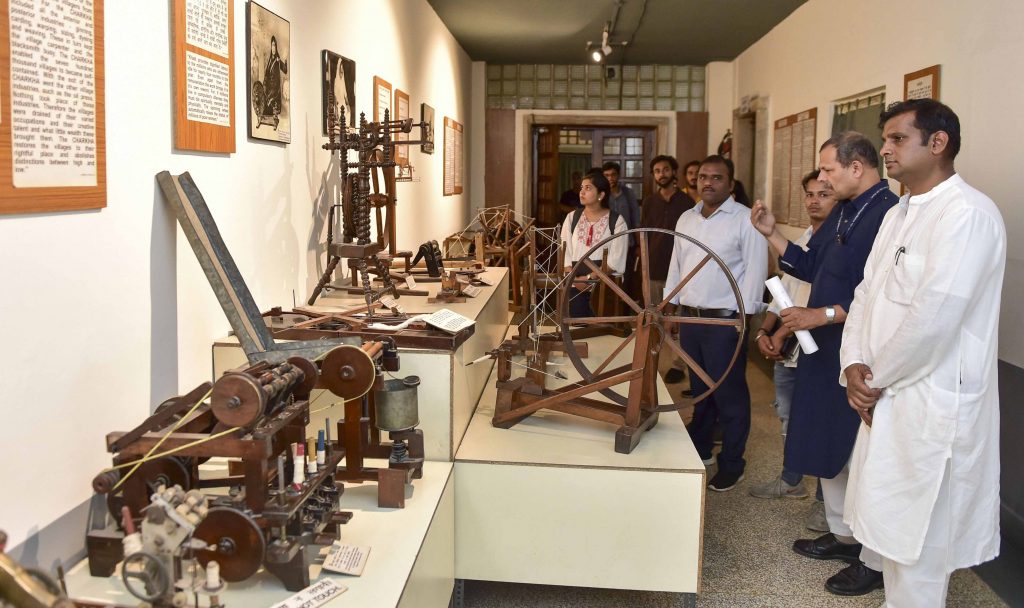New Delhi: From a replica of Mahatma Gandhi’s residence at Sabarmati Ashram to his ‘recreated heartbeat’ in a digital medium – the National Gandhi Museum has an eclectic atmosphere to pay tributes to the ‘Father of the Nation’ on his 150th birth anniversary.
Decked up to the hilt to celebrate the occasion, the museum, standing in this location since 1961, provides a complete panorama of Mahatma Gandhi’s life, work and philosophy through the many relics, photographs, art works, audio-visuals and literature.
Go there and you will find yourself standing next to ‘Hridaya Kunj’ – a replica of Gandhi’s residence in the Sabarmati Ashram from 1915 to 1930. One can make a note of Gandhi’s life-long philosophy of ‘simple living’ up close and personal, or walk upstairs and pick up a phone placed there to hear Gandhi’s voice on the other side giving his eternal message of ‘peace, love and brotherhood’.
The relatively latest addition to the repository of Gandhi’s collection is his ‘recreated heartbeat’ in a digital medium. The heartbeat was recreated after gathering the electrocardiography (ECG) details from different stages of Mahatma Gandhi’s life.
Soon after listening to the heartbeat, an excited nine-year-old beamed with joy, “Did you hear it? This is so unreal. Wait I’ll tell my mother also.”
Besides over 300 photographs related to Gandhi from his early childhood till his death in the photo gallery, it also contains Gandhian memorabilia like his spectacles, microscope, pen, watches, sandals, utensils, books, diaries or even the stick he used in the famous Dandi March.
‘Charkha’ (spinning wheel), which was a constant companion of Mahatma Gandhi in his freedom struggle for India, finds itself a separate gallery in the museum.
For 24-year-old Samir Ahuja, the visit was very ‘educative’ as he got to know about many of Mahatma Gandhi’s interest which he was completely unaware of earlier.
“There are just so many things. For example, I was not aware of Gandhi’s interest in astronomy. It displays three of astronomy books that were read by Gandhi along with law books. Just when you think that you know this man, he surprises you,” Ahuja stated.
Contrary to the excited crowd was Ram Saran Sharma, who was sitting in a corner reading a newspaper. Once involved in the process of developing innumerable photographs of Gandhi that now adorn the walls of the museum, he said what disturbs him the most now is the incessant clicking of ‘selfies’ by visitors.
“These days many of them just come because they want to get a selfie. Not to understand and learn. They don’t realise what they are missing out,” said the 68-year-old Sharma. He recalled that was not the case earlier as back in the day ‘people used to stop and ask about different photographs or relics, and then make notes of it’.
However, Neha Gandhotra, 32, an IT professional, who voluntarily dropped her electronic devices in the car before entering the museum, has a different story to tell.
“I come here for peace. Didn’t feel like bringing the chaos with me inside. It is no less than a pilgrim for me,” Gandotra, who is a firm believer of Gandhian way of living, said.
Together with some of the famous and widely published photographs of Mahatma Gandhi, there are some candid ones also like the one where he is seen swimming in the Cape Comrin in Tamil Nadu and the other where he is patting a young calf or even the one where he is resting on a bed and six-year-old Indira Gandhi is posing next to him.
The last part of the museum, martyrdom gallery, made for the emotional part of the whole tour as it features an urn containing Gandhi’s ashes, his blood-stained shawl, one of the bullets which killed him along with his pocket watch – the one that was with him at the last moments of his life.
PTI
